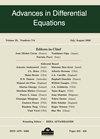具有次线性非线性的临界阻尼Schrödinger方程的有限时间消光
IF 1.9
3区 数学
Q1 MATHEMATICS
引用次数: 2
摘要
本文完成了几位作者以前关于非线性薛定谔方程的有限时间消光的一些研究,当非线性阻尼项对应于一些“饱和非克尔定律”的极限情况时,$F(|u|^2)u=\frac{a}{\varepsilon+(|u| ^2)^\alpha}u,$with$a\in\mathbb{C},$$varepsilon\geqslant0,$$2\alpha=(1-m)$和$m\in[0,1).$在这里,我们考虑次线性情况$00\text{and}2\sqrt{m}\mathrm{Im}(z)=(1-m)\mathrm{Re}(z)\bigh\}。$除其他外,我们知道这个阻尼系数是关键的,例如,为了获得相关算子的单调性(参见Liskevich和Perel'muter[16]的论文以及Cialdea和Maz'ya[14]的最新研究)。在获得近似的先验估计后,用适当的能量方法证明了解的有限时间消光。大多数结果适用于不一定有界的空间域。本文章由计算机程序翻译,如有差异,请以英文原文为准。
Finite time extinction for a critically damped Schrödinger equation with a sublinear nonlinearity
This paper completes some previous studies by several authors on the finite time extinction for nonlinear Schr{\"o}dinger equation when the nonlinear damping term corresponds to the limit cases of some ``saturating non-Kerr law'' $F(|u|^2)u=\frac{a}{\varepsilon+(|u|^2)^\alpha}u,$ with $a\in\mathbb{C},$ $\varepsilon\geqslant0,$ $2\alpha=(1-m)$ and $m\in[0,1).$ Here we consider the sublinear case $00 \text{ and } 2\sqrt{m}\mathrm{Im}(z)=(1-m)\mathrm{Re}(z)\big\}.$ Among other things, we know that this damping coefficient is critical, for instance, in order to obtain the monotonicity of the associated operator (see the paper by Liskevich and Perel'muter [16] and the more recent study by Cialdea and Maz'ya [14]). The finite time extinction of solutions is proved by a suitable energy method after obtaining appropiate a priori estimates. Most of the results apply to non-necessarily bounded spatial domains.
求助全文
通过发布文献求助,成功后即可免费获取论文全文。
去求助
来源期刊

Advances in Differential Equations
MATHEMATICS, APPLIED-MATHEMATICS
CiteScore
1.90
自引率
0.00%
发文量
0
审稿时长
>12 weeks
期刊介绍:
Advances in Differential Equations will publish carefully selected, longer research papers on mathematical aspects of differential equations and on applications of the mathematical theory to issues arising in the sciences and in engineering. Papers submitted to this journal should be correct, new and non-trivial. Emphasis will be placed on papers that are judged to be specially timely, and of interest to a substantial number of mathematicians working in this area.
 求助内容:
求助内容: 应助结果提醒方式:
应助结果提醒方式:


